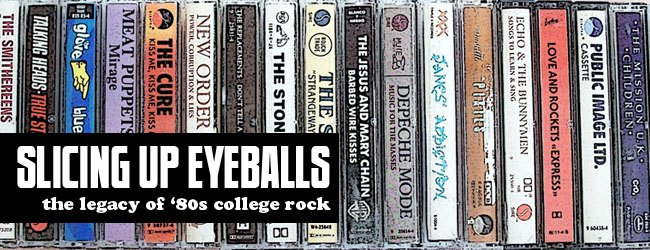
Bassist and songwriter David J will tell the stories behind seminal goth-rock act Bauhaus and its successor Love and Rockets — as well as tales from his own solo career and his exploration of the occult — in a new memoir entitled “Who Killed Mister Moonlight?: Bauhaus, Black Magick and Benediction” that’s due to be published this fall.
Billed as “a rock ‘n’ roll memoir like no other, “the 320-page paperback is set to be published Oct. 15 by Jawbone Press, and promises “a no-holds-barred account of (Bauhaus’) rapid rise to fame and glory in the late ’70s, their sudden dissolution in the ’80s, and their subsequent — and often strained — reunions.”
David J recently offered the first taste of the memoir, posting this excerpt about Ian Curtis to Facebook:
Excerpt: “Who Killed Mister Moonlight?: Bauhaus, Black Magick and Benediction”
This colourful and seedy area of London became the backdrop to our residency at Billy’s in Dean Street. The dingy little club was a seething cauldron for the witches’ brew that would eventually be labelled ‘goth’ and would soon host the infamous Batcave nights. During the course of our five shows at the venue, we saw the audience evolve and establish its own code, in terms both of dress and attitude.
Black was of course the only way to go: the colour of night and death, and always the distinguishing mark of those who wished to stand outside of the norm, from existentialists to beatniks to goths. It is the flag of morbidity under which the anarchic troops of apolitical revolt rally before storming the barricades of convention.
The nineteenth-century decadents believed that it required a highly refined sensibility to truly appreciate and savour the delights of sensual sadness and the beautiful phosphorescence of decay. The goths would no doubt agree. In their disdain for the vulgar and their celebration of all that is wan, delicate, and slowly dying, they were and still are the true descendants of those poets of exquisite unease.
On one of those rainy Soho nights, we were visited by an icon of this as-yet-unnamed melancholic subculture when Ian Curtis appeared at the end of a set during which a wild and abandoned Murphy had laid waste to a wall of mirrors. We had always felt that there was a sympathetic resonance between Joy Division and us. The tall, gangly singer told us that he had come with Factory Records boss Tony Wilson, who had apparently left after the first number as he strongly objected to bands that wore makeup.
‘It were ’is fooking loss, man,’ he told us. ‘He really missed out tonight. Fook him. He’s a cunt, anyway!’
Ian said he thought the gig was great, that both our singles were excellent, and that he had been hoping that Joy Division’s recent recording sessions (for Closer) would coincide with one of our live shows.
Many years later, I would get chills when reading of this desire in Ian’s own hand, in a letter to his mistress, Annik Honore, a copy of which had been lent to me (with the rest of Ian’s letters) by Michael Stock, the screenwriter and would-be director of an early biopic about Ian. Although Ian was cheery and warm that night at Billy’s, I remember a look in his watery blue eyes that was so sad and haunted. Three months later, he hung himself in his kitchen.
On May 3, we played a gig at the Russell Club in Manchester. Joy Division bassist Peter Hook was there, helping us load out our gear as he often would. After we had packed up, we went out with Peter and his manager, Rob Gretton. The band had recently released a limited edition single on the Sordide Sentimentale label consisting of ‘Atmosphere’ on one side and ‘Dead Souls’ on the other. It was only available in France, so I had been unable to find a copy. I mentioned this to Rob, and he very kindly said that he would send me one. It turned up on my doormat, two weeks later, the day after Ian’s death.
I had never heard ‘Atmosphere’ before. I slipped the seven-inch out of the beautiful, elaborate sleeve, which featured a painting of hooded monks on a mist-shrouded mountain by the artist Jean-François Jamoul. There was also a striking photograph of the band by Anton Corbijn. In light of the tragedy, the majestic track was almost unbearably poignant. With some trepidation, and a tear in my eye, I called Rob to thank him and to commiserate over the terrible news. He could hardly speak.
PREVIOUSLY ON SLICING UP EYEBALLS
- Bauhaus’ David J covers Britney Spears’ ‘Toxic’ in Sasha Grey-starring NSFW video
- Stream: David J premieres ‘You Suit a Rainy Day’ — first single off ‘An Eclipse of Ships’
- Bauhaus’ David J turns to Kickstarter to fund new solo album ‘An Eclipse of Ships’
- Stream: Bauhaus’ David J with Jill Tracy, ‘Bela Lugosi’s Dead (Undead is Forever)’
- Q&A: Bauhaus’ David J on his ‘accidental’ concept album ‘Not Long For This World’













This should be good. Still curious as to what really happened behind the final Bauhaus breakup, before they could really finish “Go Away White” and do a support tour.
Wow. I can’t wait to read this. What a great writing style!
To heck with Bauhaus and Ian Curtis… I want to hear David dish dirt on his days with the Jazz Butcher Conspiracy!
I hear that!!!
I’m guessing it’ll be a case of “no new tales to tell,” but a lot of really great old ones.
This is one I have to get.
After hanging together for 35+ years people change. Some more than others. Don’t you have old friends that went on a different path in life?